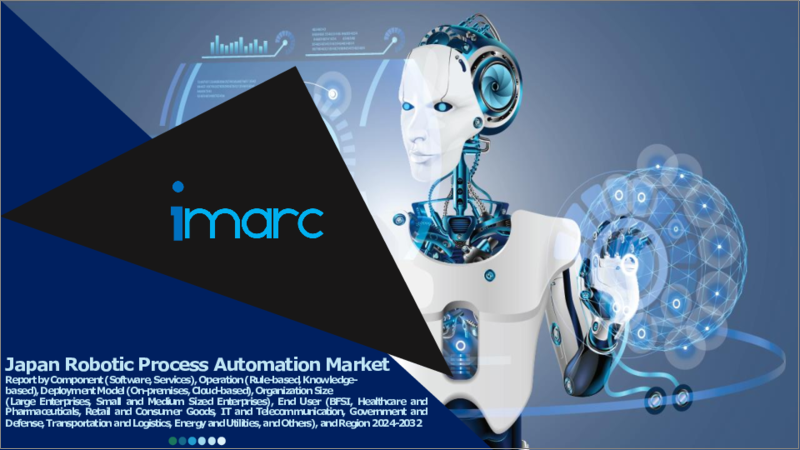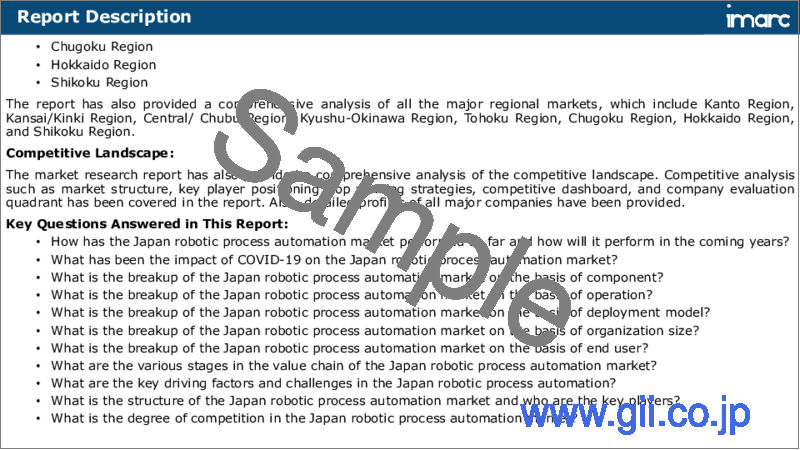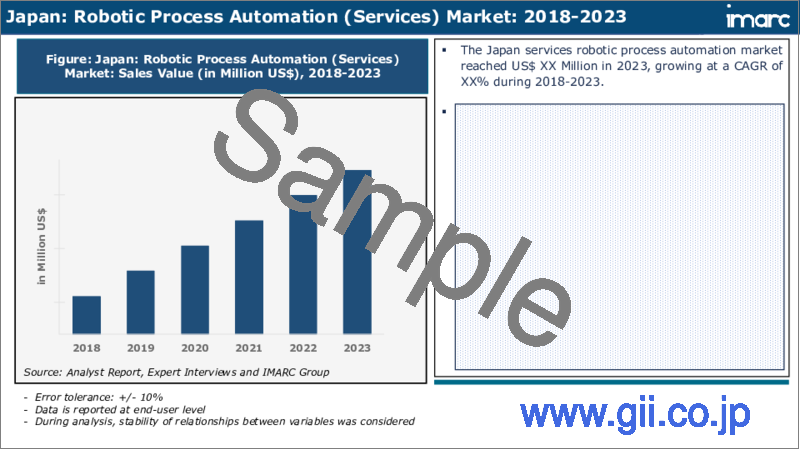|
|
市場調査レポート
商品コード
1609679
日本のロボティックプロセスオートメーション(RPA)市場レポート:コンポーネント、オペレーション、展開モデル、組織規模、エンドユーザー、地域別、2024年~2032年Japan Robotic Process Automation Market Report by Component, Operation, Deployment Model, Organization Size, End User, and Region 2024-2032 |
||||||
カスタマイズ可能
|
|||||||
| 日本のロボティックプロセスオートメーション(RPA)市場レポート:コンポーネント、オペレーション、展開モデル、組織規模、エンドユーザー、地域別、2024年~2032年 |
|
出版日: 2024年12月05日
発行: IMARC
ページ情報: 英文 117 Pages
納期: 5~7営業日
|
- 全表示
- 概要
- 目次
日本のロボティックプロセスオートメーション(RPA)市場の市場規模は2023年に5億8,928万米ドルに達しました。今後、IMARC Groupは、同市場が2024年から2032年の間に24.70%の成長率(CAGR)を示し、2032年までに53億7,069万米ドルに達すると予測しています。日本全体における製造業の自動化需要の増加、労働人口の急速な高齢化、日本企業の意識の高まり、各業界におけるデジタルトランスフォーメーションへの取り組みの高まり、先端技術の統合などが、市場を牽引する主な要因となっています。
本レポートで扱う主な質問
- 日本のロボティックプロセスオートメーション(RPA)市場はこれまでどのように推移し、今後どのように推移するのか?
- COVID-19が日本のロボティックプロセスオートメーション(RPA)市場に与えた影響は?
- 日本のロボティックプロセスオートメーション(RPA)市場のコンポーネント別の内訳は?
- 日本のロボティックプロセスオートメーション(RPA)市場のオペレーション別の内訳は?
- 日本のロボティックプロセスオートメーション(RPA)市場の展開モデルでの内訳は?
- 日本のロボティックプロセスオートメーション(RPA)市場の組織規模別内訳は?
- 日本のロボティックプロセスオートメーション(RPA)市場のエンドユーザー別の内訳は?
- 日本のロボティックプロセスオートメーション(RPA)市場のバリューチェーンにはどのような段階がありますか?
- 日本のロボティックプロセスオートメーション(RPA)における主な促進要因と課題は?
- 日本のロボティックプロセスオートメーション(RPA)市場の構造と主要プレーヤーは?
- 日本のロボティックプロセスオートメーション(RPA)市場における競合の程度は?
目次
第1章 序文
第2章 調査範囲と調査手法
- 調査の目的
- ステークホルダー
- データソース
- 市場推定
- 調査手法
第3章 エグゼクティブサマリー
第4章 日本のロボティックプロセスオートメーション(RPA)市場:イントロダクション
- 概要
- 市場力学
- 業界動向
- 競合情報
第5章 日本のロボティックプロセスオートメーション(RPA)市場情勢
- 過去および現在の市場動向(2018~2023年)
- 市場予測(2024~2032年)
第6章 日本のロボティックプロセスオートメーション(RPA)市場:コンポーネント別の内訳
- ソフトウェア
- サービス
第7章 日本のロボティックプロセスオートメーション(RPA)市場:オペレーション別の内訳
- ルールベース
- 知識ベース
第8章 日本のロボティックプロセスオートメーション(RPA)市場:展開モデル別の内訳
- オンプレミス
- クラウドベース
第9章 日本のロボティックプロセスオートメーション(RPA)市場:組織規模別の内訳
- 大企業
- 中小企業
第10章 日本のロボティックプロセスオートメーション(RPA)市場:エンドユーザー別の内訳
- BFSI
- ヘルスケアと医薬品
- 小売・消費財
- IT・通信
- 政府と防衛
- 運輸・物流
- エネルギーと公共事業
- その他
第11章 日本のロボティックプロセスオートメーション(RPA)市場:競合情勢
- 概要
- 市場構造
- 市場プレーヤーのポジショニング
- 主要成功戦略
- 競合ダッシュボード
- 企業評価象限
第12章 主要企業のプロファイル
第13章 日本のロボティックプロセスオートメーション(RPA)市場:業界分析
- 促進要因・抑制要因・機会
- ポーターのファイブフォース分析
- バリューチェーン分析
第14章 付録
Japan robotic process automation market size reached US$ 589.28 Million in 2023. Looking forward, IMARC Group expects the market to reach US$ 5,370.69 Million by 2032, exhibiting a growth rate (CAGR) of 24.70% during 2024-2032. The increasing demand for automation in manufacturing across Japan, rapidly aging workforce, growing awareness among Japanese businesses, rising digital transformation initiatives across industries, and the integration of advanced technologies represent some of the key factors driving the market.
Robotic process automation (RPA) refers to a technology that utilizes software robots or 'bots' to automate repetitive, routine tasks that are traditionally performed by human workers. It operates by mimicking the actions of a human interacting with digital systems to execute business processes. RPA can log into applications, enter data, calculate, complete tasks, and then log out. It is characterized by its ability to integrate various technologies like artificial intelligence (AI), machine learning (ML), and workflow automation. RPA is comprised of various components, such as software, bots, and a control dashboard for management. It possesses several features, including non-invasiveness, scalability, and reliability. RPA finds applications in a wide array of industries and sectors, including finance, healthcare, telecommunications, manufacturing, insurance, customer service, and human resources. It aids in reducing operational costs, increasing efficiency, improving accuracy, ensuring compliance, enhancing customer experience, boosting employee satisfaction, and optimizing strategic workforce allocation. In addition, RPA is known for its cost-effectiveness, flexibility, non-disruptiveness, ease of use, rapid return on investment (ROI), and minimization of errors.
Japan Robotic Process Automation Market Trends:
The increasing demand for automation in manufacturing across Japan to improve efficiency and productivity is propelling the market growth. Additionally, the rapidly aging workforce, which is creating a gap in labor, is driving the market growth. Besides this, the growing awareness among Japanese businesses about the benefits of RPA in terms of cost reduction and operational efficiency is creating a positive outlook for the market. Furthermore, the rising digital transformation initiatives across industries in Japan are fostering the market growth. In addition, the ongoing government push towards promoting the integration of digital technologies into various sectors is catalyzing the market growth. Apart from this, the introduction of customized RPA solutions tailored to specific industry needs is fueling the market growth. Moreover, the integration of advanced technologies, such as AI and ML, which are enhancing the capabilities of RPA, thus attracting more users, is positively influencing the market growth. Along with this, the growing emphasis on customer service and the need for its optimization through automation is favoring the market growth. In line with this, the emerging trend of remote working in Japan is facilitating the demand for RPA to ensure smooth business operations. In addition, the entry of global and local RPA solution providers into the Japanese market, offering competitive and innovative solutions, is bolstering the market growth. Furthermore, the growing demand for RPA, as it offers a quick return on investment (ROI) owing to its efficiency and cost savings, is driving the market growth.
Japan Robotic Process Automation Market Segmentation:
Component Insights:
- Software
- Services
Operation Insights:
- Rule-based
- Knowledge-based
Deployment Model Insights:
- On-premises
- Cloud-based
Organization Size Insights:
- Large Enterprises
- Small and Medium Sized Enterprises
End User Insights:
- BFSI
- Healthcare and Pharmaceuticals
- Retail and Consumer Goods
- IT and Telecommunication
- Government and Defense
- Transportation and Logistics
- Energy and Utilities
- Others
Competitive Landscape:
The market research report has also provided a comprehensive analysis of the competitive landscape. Competitive analysis such as market structure, key player positioning, top winning strategies, competitive dashboard, and company evaluation quadrant has been covered in the report. Also, detailed profiles of all major companies have been provided.
Key Questions Answered in This Report:
- How has the Japan robotic process automation market performed so far and how will it perform in the coming years?
- What has been the impact of COVID-19 on the Japan robotic process automation market?
- What is the breakup of the Japan robotic process automation market on the basis of component?
- What is the breakup of the Japan robotic process automation market on the basis of operation?
- What is the breakup of the Japan robotic process automation market on the basis of deployment model?
- What is the breakup of the Japan robotic process automation market on the basis of organization size?
- What is the breakup of the Japan robotic process automation market on the basis of end user?
- What are the various stages in the value chain of the Japan robotic process automation market?
- What are the key driving factors and challenges in the Japan robotic process automation?
- What is the structure of the Japan robotic process automation market and who are the key players?
- What is the degree of competition in the Japan robotic process automation market?
Table of Contents
1 Preface
2 Scope and Methodology
- 2.1 Objectives of the Study
- 2.2 Stakeholders
- 2.3 Data Sources
- 2.3.1 Primary Sources
- 2.3.2 Secondary Sources
- 2.4 Market Estimation
- 2.4.1 Bottom-Up Approach
- 2.4.2 Top-Down Approach
- 2.5 Forecasting Methodology
3 Executive Summary
4 Japan Robotic Process Automation Market - Introduction
- 4.1 Overview
- 4.2 Market Dynamics
- 4.3 Industry Trends
- 4.4 Competitive Intelligence
5 Japan Robotic Process Automation Market Landscape
- 5.1 Historical and Current Market Trends (2018-2023)
- 5.2 Market Forecast (2024-2032)
6 Japan Robotic Process Automation Market - Breakup by Component
- 6.1 Software
- 6.1.1 Overview
- 6.1.2 Historical and Current Market Trends (2018-2023)
- 6.1.3 Market Forecast (2024-2032)
- 6.2 Services
- 6.2.1 Overview
- 6.2.2 Historical and Current Market Trends (2018-2023)
- 6.2.3 Market Forecast (2024-2032)
7 Japan Robotic Process Automation Market - Breakup by Operation
- 7.1 Rule-based
- 7.1.1 Overview
- 7.1.2 Historical and Current Market Trends (2018-2023)
- 7.1.3 Market Forecast (2024-2032)
- 7.2 Knowledge-based
- 7.2.1 Overview
- 7.2.2 Historical and Current Market Trends (2018-2023)
- 7.2.3 Market Forecast (2024-2032)
8 Japan Robotic Process Automation Market - Breakup by Deployment Model
- 8.1 On-premises
- 8.1.1 Overview
- 8.1.2 Historical and Current Market Trends (2018-2023)
- 8.1.3 Market Forecast (2024-2032)
- 8.2 Cloud-based
- 8.2.1 Overview
- 8.2.2 Historical and Current Market Trends (2018-2023)
- 8.2.3 Market Forecast (2024-2032)
9 Japan Robotic Process Automation Market - Breakup by Organization Size
- 9.1 Large Enterprises
- 9.1.1 Overview
- 9.1.2 Historical and Current Market Trends (2018-2023)
- 9.1.3 Market Forecast (2024-2032)
- 9.2 Small and Medium Sized Enterprises
- 9.2.1 Overview
- 9.2.2 Historical and Current Market Trends (2018-2023)
- 9.2.3 Market Forecast (2024-2032)
10 Japan Robotic Process Automation Market - Breakup by End User
- 10.1 BFSI
- 10.1.1 Overview
- 10.1.2 Historical and Current Market Trends (2018-2023)
- 10.1.3 Market Forecast (2024-2032)
- 10.2 Healthcare and Pharmaceuticals
- 10.2.1 Overview
- 10.2.2 Historical and Current Market Trends (2018-2023)
- 10.2.3 Market Forecast (2024-2032)
- 10.3 Retail and Consumer Goods
- 10.3.1 Overview
- 10.3.2 Historical and Current Market Trends (2018-2023)
- 10.3.3 Market Forecast (2024-2032)
- 10.4 IT and Telecommunication
- 10.4.1 Overview
- 10.4.2 Historical and Current Market Trends (2018-2023)
- 10.4.3 Market Forecast (2024-2032)
- 10.5 Government and Defense
- 10.5.1 Overview
- 10.5.2 Historical and Current Market Trends (2018-2023)
- 10.5.3 Market Forecast (2024-2032)
- 10.6 Transportation and Logistics
- 10.6.1 Overview
- 10.6.2 Historical and Current Market Trends (2018-2023)
- 10.6.3 Market Forecast (2024-2032)
- 10.7 Energy and Utilities
- 10.7.1 Overview
- 10.7.2 Historical and Current Market Trends (2018-2023)
- 10.7.3 Market Forecast (2024-2032)
- 10.8 Others
- 10.8.1 Historical and Current Market Trends (2018-2023)
- 10.8.2 Market Forecast (2024-2032)
11 Japan Robotic Process Automation Market - Competitive Landscape
- 11.1 Overview
- 11.2 Market Structure
- 11.3 Market Player Positioning
- 11.4 Top Winning Strategies
- 11.5 Competitive Dashboard
- 11.6 Company Evaluation Quadrant
12 Profiles of Key Players
- 12.1 Company A
- 12.1.1 Business Overview
- 12.1.2 Product Portfolio
- 12.1.3 Business Strategies
- 12.1.4 SWOT Analysis
- 12.1.5 Major News and Events
- 12.2 Company B
- 12.2.1 Business Overview
- 12.2.2 Product Portfolio
- 12.2.3 Business Strategies
- 12.2.4 SWOT Analysis
- 12.2.5 Major News and Events
- 12.3 Company C
- 12.3.1 Business Overview
- 12.3.2 Product Portfolio
- 12.3.3 Business Strategies
- 12.3.4 SWOT Analysis
- 12.3.5 Major News and Events
- 12.4 Company D
- 12.4.1 Business Overview
- 12.4.2 Product Portfolio
- 12.4.3 Business Strategies
- 12.4.4 SWOT Analysis
- 12.4.5 Major News and Events
- 12.5 Company E
- 12.5.1 Business Overview
- 12.5.2 Product Portfolio
- 12.5.3 Business Strategies
- 12.5.4 SWOT Analysis
- 12.5.5 Major News and Events
13 Japan Robotic Process Automation Market - Industry Analysis
- 13.1 Drivers, Restraints, and Opportunities
- 13.1.1 Overview
- 13.1.2 Drivers
- 13.1.3 Restraints
- 13.1.4 Opportunities
- 13.2 Porters Five Forces Analysis
- 13.2.1 Overview
- 13.2.2 Bargaining Power of Buyers
- 13.2.3 Bargaining Power of Suppliers
- 13.2.4 Degree of Competition
- 13.2.5 Threat of New Entrants
- 13.2.6 Threat of Substitutes
- 13.3 Value Chain Analysis





